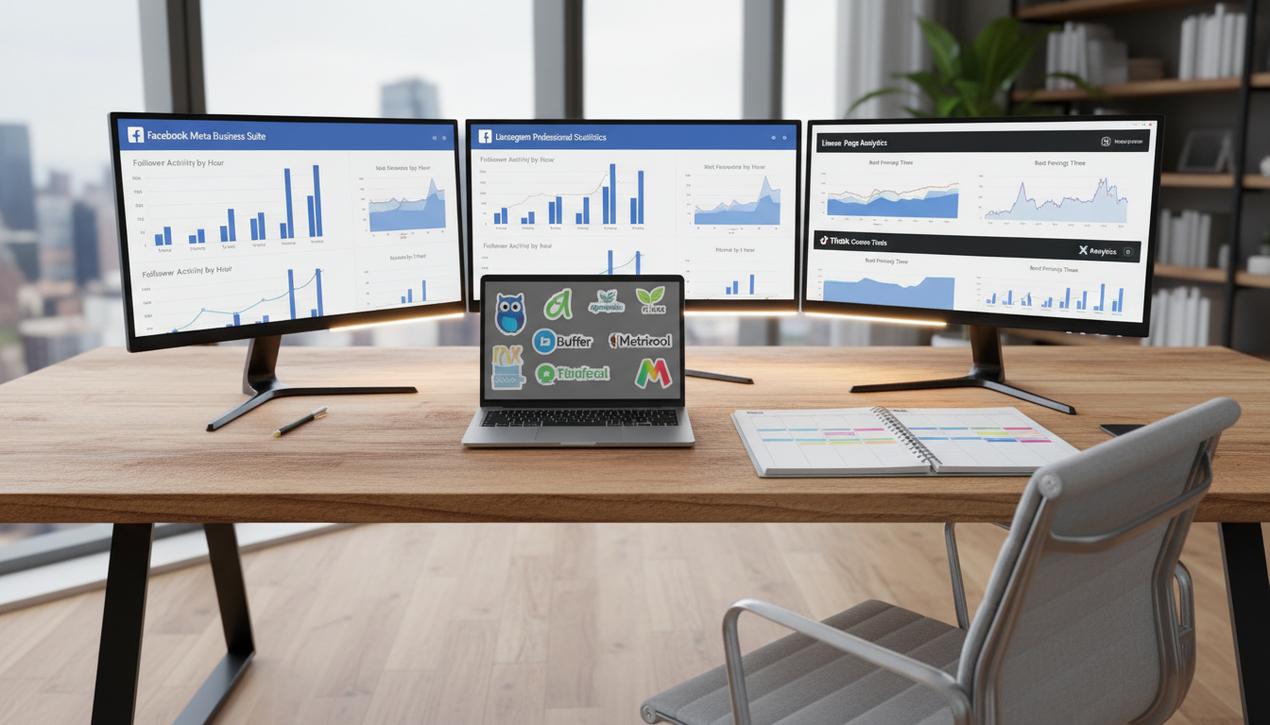When to Post on Social Media: The Ultimate 2025 Guide


In the crowded digital landscape of 2025, creating high-quality content is only half the battle. Timing is everything. Posting at the wrong moment is like whispering your message in a packed stadium—no matter how brilliant it is, it gets lost in the noise. Today’s social media algorithms heavily favor initial engagement. A post that quickly gathers likes, comments, and shares is far more likely to be shown to a wider audience. In fact, studies show that posting at optimal times can boost your organic reach by over 30%. Yet, there is no universal magic formula. The perfect posting time depends on a mix of factors: your industry, the specific platform, and most importantly, the unique behavior of your audience. This comprehensive guide moves beyond generic advice to provide a data-driven methodology based on 2025 trends, helping you pinpoint the exact moments your community is most receptive and ready to engage.
The Foundation: Understanding Your Audience First
Before diving into statistics and tools, the fundamental first step is knowing who you’re talking to. Trying to find the best time to post without a deep understanding of your audience is like navigating without a compass. Every online community has its own rhythm, habits, and peak activity times.
1. Build Your Audience Persona
Your strategy must begin with a clear picture of your ideal customer or user. Answering these key questions will help you create an accurate profile:
- Industry Focus: Are you a B2B company targeting professionals or a B2C brand speaking to consumers? Their online habits are worlds apart. A B2B executive is likely active on LinkedIn during business hours, while a B2C consumer is more inclined to browse Instagram or TikTok in the evening.
- Demographics: What is your target age group? A college student’s daily schedule is completely different from that of a working parent. The student might be online during their commute, between classes, and late at night. The parent, however, will have more defined windows of activity, like their lunch break or after the kids are in bed.
- Location: Is your audience local, national, or international? Managing time zones is critical if you’re targeting a global audience. You may need to schedule multiple posts or identify a time slot that overlaps with the majority of your followers’ waking hours.
2. Leverage Native Platform Analytics
Every major social network provides powerful, free analytics tools. This is a goldmine of data for understanding your existing followers’ behavior.
- Facebook (via Meta Business Suite): In the “Insights” tab under “Content,” you’ll find detailed charts showing the days and hours your followers are most active online.
- Instagram (Professional Accounts): Navigate to your “Professional Dashboard,” then “Account Insights.” The “Total Followers” section reveals the peak days and times your community is browsing.
- LinkedIn (Company Pages): The “Analytics” tab under “Visitors” provides valuable data on your visitor demographics and traffic spikes on your page.
- TikTok (Pro Accounts): In the Creator Tools, the “Analytics” tab under “Followers” displays your follower activity by the hour and day over the last week.
- X (formerly Twitter): The native X Analytics tool allows you to analyze your post performance, helping you spot trends in which times generate the most impressions and engagement.
Best Times to Post: 2025 Data by Platform
While your own data is always the priority, general industry studies provide an excellent starting point for your experiments. Treat these time slots as educated hypotheses to be tested, not as inflexible rules.
Facebook: The Versatile Giant
With its massive and diverse user base, the best times to post can vary widely. To maximize impact, combining the right timing with engaging content, such as Facebook contest ideas, is key.
- General Trend: Weekday mornings between 8 AM and 12 PM are strong, as people check their feeds before starting work or during their first break.
- For B2C: Weekends, especially Saturday around 11 AM, and late weekday afternoons (3 PM – 5 PM) often see high engagement.
- For B2B: Focus on weekdays, with Tuesdays and Thursdays being particularly effective for reaching a professional audience.
Instagram: The Visual Engagement Kingdom
This platform thrives on interaction, and usage is heavily mobile-driven.
- General Trend: The lunch break (11 AM – 2 PM) and the end of the workday (6 PM – 8 PM) are peak times.
- Reels vs. Stories: Reels, consumed as quick entertainment, perform exceptionally well in the evenings, between 8 PM and 10 PM. Stories get consistent engagement throughout the day as users check in frequently.
- Weekend Power: Sunday afternoon is an often-overlooked but highly effective time slot to reach a relaxed and engaged audience.
LinkedIn: The Professional Network
Activity is almost exclusively concentrated during the workweek.
- Best Days: Tuesday through Thursday. Mondays are often busy with meetings, and attention drops off on Fridays.
- Prime Time Slots: The “transition” hours are key: before work (8 AM – 9 AM), during the lunch break (12 PM – 1 PM), and right after the workday (5 PM – 6 PM).
TikTok: The Short-Form Viral Empire
The audience is generally younger and uses the app for entertainment and relaxation.
- General Trend: Late afternoons and evenings, from 4 PM to 11 PM, with significant peaks after 7 PM.
- Weekend Activity: Engagement remains high throughout Saturday and Sunday, with strong viewership in the afternoons.
Tools to Schedule and Optimize Your Posts
Manually managing posting times across multiple social networks is time-consuming and inefficient. Fortunately, a wide range of tools can help you automate this process and make data-driven decisions.
All-in-One Management Platforms
These tools go beyond simple scheduling; they analyze your performance to recommend the most effective time slots.
- Hootsuite: An industry leader that offers a “Best time to publish” feature based on your past engagement history and audience activity.
- Buffer: Known for its intuitive interface, Buffer analyzes your past posts and suggests optimal time slots to fill your publishing queue.
- Agorapulse: A powerful tool that provides detailed reports to easily identify your best-performing content and posting times, in addition to scheduling.
- Sprout Social: Its patented “ViralPost” feature uses machine learning to analyze your audience’s usage data and determines the moments your content is most likely to drive engagement.
- Metricool: Offers an excellent planner that uses a color-coded system to show you the “hot hours” for each social network connected to your account.
Smart Automation for a Smarter Strategy
Most of these platforms offer an “auto-schedule” option. By enabling it, you no longer have to manually select a time. You simply add your content to a queue, and the tool will automatically publish it at the next optimal slot it identifies. This is a significant time-saver that maximizes the reach of every single post.
Building a Strategy for Continuous Testing and Improvement
You’ve analyzed your audience and studied the trends. Now it’s time to validate your hypotheses with a methodical approach.
1. Create a Testing Calendar
Don’t just post randomly. Establish a structured plan over several weeks. For example:
- Week 1: Test morning time slots (e.g., 8 AM, 9 AM, 10 AM).
- Week 2: Test midday time slots (e.g., 12 PM, 1 PM, 2 PM).
- Week 3: Test late-afternoon time slots (e.g., 5 PM, 6 PM, 7 PM).
- Week 4: Test evening time slots (e.g., 8 PM, 9 PM).
To ensure the test is reliable, publish content of a similar type and quality in each time slot.
2. Measure Your Results Rigorously
Track the performance of each post after 24 hours. Use a spreadsheet to log key metrics: day, time, reach, impressions, likes, comments, shares, and clicks on your calls-to-action. After a few weeks of consistent testing, clear patterns will begin to emerge.
3. Match Content Type to the Time of Day
An advanced strategy involves aligning the format and tone of your content with the posting time. A long-form article or an in-depth video tutorial will be better received during a lunch break, while lighter, more entertaining content like a meme or an interactive Story will perform better in the evening.
Finding the best time to post on social media is not an exact science but a strategic, iterative process. In 2025, success isn’t about applying a one-size-fits-all solution but about actively listening to your community. By combining deep audience knowledge, rigorous data analysis, and the use of intelligent tools, you will transform your content calendar into a powerful engine for growth. Stay curious, test constantly, and be ready to adapt, because user behavior evolves just as quickly as the algorithms that power these platforms.




